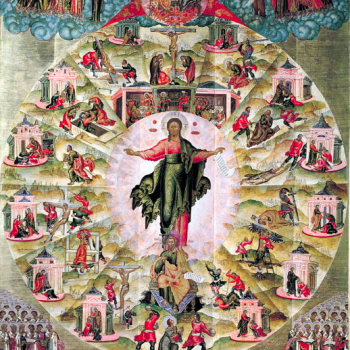There are lots of things having to do with sexual difference that I don't know. As I said some time ago, I don't know why women don't have the priesthood. I don't have a theological response to the issues that LGBT people raise in their relationships with the LDS Church. These are among the knotty problems that desperately need answers, but I am not equipped to give those answers. I can, however, speak to a narrower topic, that of how I understand the implications of LDS theology for traditional couples.
Scripture, particularly that in the Bible, frequently uses the image of the male-female espoused or married couple as the image of the relationship of God to his people. That image is at the heart of Latter-day Saint theology, so much so that it has literal as well as symbolic significance. God's goal is to bring us to himself in a permanent relationship of love, a relationship that obtains between him and each of us, as well as between each of us and everyone else. Those relationships are physico-spiritual relationships rather than only spiritual ones.
For Mormons, the highest heaven is a web of relationships with the Godhead at the center and all other beings bound to them and to each other in a reduplication of their unity. As I understand it, that is essential to what it means to become like God. God's purposes are ultimately about the creation of that unity, and that creation of unity begins most obviously with the bonding of male and female in marriage. But the marriage bond has an even earlier origin.
Latter-day Saints believe that something about our personalities has always existed. Early in church history (which for Mormons means "in the 19th century") most Mormons believed that the original, uncreated part of our existence, called intelligence, had not been eternally individualized. Individualization came by God, as it were, taking a portion of the basic material—intelligence—and creating an individual spirit.
By the end of the 19th century and the beginning of the 20th, that understanding began to change. Today most Mormons appear to believe that individuals have always existed as individuals, that intelligence has always been individualized. The Church's official "The Family: A Proclamation to the World" may take the more modern position when it speaks of "individual premortal, mortal, and eternal" identity and purpose.
In either case, LDS teaching understands the creation of persons to be ongoing: I have always existed in some way or another, but my purpose is to become a person who is more and more like my Father and Mother in Heaven until I am finally joined in unity with them forever. Becoming like God requires that I go through a series of stages, from becoming a human body to eventually becoming one with God, which means becoming like my Heavenly Parents and their Son, Jesus Christ.
Initially those stages are matters that pertain mostly to the most individualized aspect of my being, that which I usually think of as what I am. But the point of my being is not merely to be that embodied individual who says "I." I ought to be the best individual that I can, developing my abilities as I have opportunity, but as long as I am merely individual, I am sold short. Being an individual person is not the end of becoming a person. Fullness of life can come only when I am joined with other individuals, and that jointure is not just conceptual or metaphorical.
The highest liturgy in the LDS Church is that of "sealing," in which two people are sealed to each other for time and eternity in marriage by covenant that is ratified by sacred authority. Sealing is the rite by which the web of relationships is created.
This means that male-female sexual difference is at the heart of sealing, for to be sealed to another person in marriage means, in principle, to be able to reproduce sexually, to birth, foster, raise, and nourish children in a relationship that cannot be broken. It means also that we can be sealed in the relationships that have made our lives together possible, in relationships with our ancestors as well as our children.
To be sealed in marriage with another is no longer to be the individual that I began as. It is to be part of a new being, a new individual, an individual with always expanding boundaries. But what becomes of me in such an ever-growing web? Do I lose my personality and become merely a function of the web?
No. I did not lose my personality by being sealed to Janice Allen, nor did she lose hers. Instead, what I am was enlarged by the permanent presence of another person, and vice-versa. We are now, physically and metaphysically, one being. Nevertheless, we have two consciousnesses and will continue to have them. We have differences and disagreements. Seldom are our disagreements over something vital, and that becomes more the case the longer we live together. But we continue to be different from one another, and I presume that will and should always be the case.





